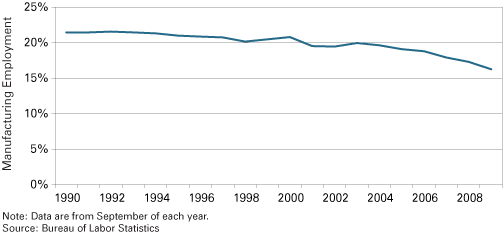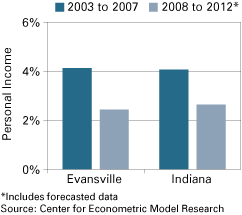Evansville Forecast 2010
Professor of Economics and Dean of Business, College of Business, University of Southern Indiana
November 2009
During every recession over the past five decades, the Evansville metro economy has exhibited resiliency and a capacity to withstand the adverse impacts associated with national recessions. The recession that began at the end of 2007 is no exception. While the declines in output, employment, real income, and real retail sales intensified in 2009, the depth of these impacts are less pronounced in Evansville than in many other metro areas of similar size and structure. The dynamics of the Evansville area labor market underscore this with a drop in the non-seasonally adjusted unemployment rate from 8.6 percent in January 2009 to 7.6 percent in September 2009, compared with a rise in the national unemployment rate from 7.6 percent to 9.8 percent over the same time period.
Economic performance in 2009 was driven by job losses in key sectors such as manufacturing, construction, and financial services. Traditional recession-resistant sectors such as health care and education were also adversely affected. Employment increases were evident only in the hospitality and government sectors. In 2009, nominal personal income is estimated to decrease by 3.1 percent and real gross metro product is estimated to decrease by 3.8 percent. The manufacturing sector continues to be an important base to metro area household incomes and consumer spending activity even as the economy adjusts to an ongoing diversification away from manufacturing-industry dependence.
As the Evansville economy tracked the U.S. economy in 2009, there were indications of a slowly improving housing market, some deterioration of credit quality, and higher delinquency rates. Homeowners experienced some home price depreciation, but the median home price has not dipped by as much as it has nationally. Existing home prices declined from an average of $94,000 in 2008 to $89,000 in 2009, and mortgage originations are estimated to increase from $715 million in 2008 to $761 million in 2009. Between 2008 and 2009, single-family housing permits are estimated to have dropped by 57 percent and personal bankruptcies per 1,000 persons are estimated to have increased from 5.1 to 8.9.
The national downturn and weaknesses in credit markets negatively impacted a number of the metro area’s largest employers. These include workforce reductions announced by a plastics firm, automotive parts manufacturers, and a financial services firm. Recent announcements from Whirlpool Corporation about the closure of its Evansville manufacturing facility in 2010 and the decision to keep its product development unit in Evansville underscore both the challenges and opportunities for the Evansville economy in the future.
In-migration, which has boosted local population growth in recent years, was not evident in 2009 as the widespread nature of the national recession has limited residents’ mobility. In 2010, the Evansville metro economy will benefit from an announced $26 million investment by Mead Johnson Nutritionals to build its new Research and Development Technology Center as well as the stimulative impacts associated with the nearly $21 million expansion by Berry Plastics.
Given the proportion of output that is sold outside the metro area, the rebound will not begin until the broader economy strengthens and demand for locally produced goods returns to the level of the preceding five years. Consequently, personal income and output growth in the next year will be below levels of the past five years.
Given Evansville’s dependence on manufacturing, the metro has been noticeably impacted since the inception of the current recession. Since September 2000, Evansville’s manufacturing workforce has fallen 25.2 percent or about 9,400 workers. As a result, manufacturing as a share of total nonfarm employment has continued to decline (see Figure 1). However, manufacturing earnings as a share of total earnings has remained stable at about 27 percent between 2001 and 2009.
Figure 1: Manufacturing Employment as a Percent of Total Nonfarm Employment in the Evansville Metro, 1990 to 2009

In 2010, output is forecasted to increase by 0.1 percent, the number of jobs is projected to decrease by 1,900, and the forecast for nominal personal income growth is zero percent. Figures 2 and 3 provide a comparison of forecasts for the Indiana segment of the Evansville economy and the state of Indiana for the 2008–2012 period.
Figure 2: Average Growth of Personal Income
|
Figure 3: Average Growth of Total Employment
|
Since the pace of structural change in the Evansville economy has quickened during the past year, there are likely to be added transitional challenges as the regional economy adjusts from its manufacturing-industry dependence, particularly in nondurable manufacturing (see Table 1). In addition, when the elderly age cohort and the youth age cohort make up large shares of the population, it places greater pressures on in-migration as a source of the human capital needs of the region.
Table 1: Manufacturing Percent of Total Employment, September 2009
| Industry | Evansville Metro | United States | Indiana |
| Manufacturing | 16.2 | 9.0 | 15.6 |
| Durable Goods | 52.3 | 60.9 | 69.4 |
| Nondurable Goods | 47.7 | 39.1 | 30.6 |
Source: Bureau of Labor Statistics
Also in this Issue…
- Outlook for 2010
- International Outlook for 2010
- U.S. Outlook for 2010
- Financial Outlook for 2010
- Housing Market Outlook for 2010
- Indiana's Outlook for 2010
- Indiana's Agricultural Outlook for 2010
- Anderson Forecast 2010
- Bloomington Forecast 2010
- Columbus Forecast 2010
- Evansville Forecast 2010
- Fort Wayne Forecast 2010
- Gary Forecast 2010
- Indianapolis-Carmel Forecast 2010
- Kokomo Forecast 2010
- Lafayette Forecast 2010
- Louisville Forecast 2010
- Muncie Forecast 2010
- Richmond Forecast 2010
- South Bend and Elkhart Area Forecast 2010
- Terre Haute Forecast 2010





